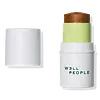What's inside
What's inside
 Key Ingredients
Key Ingredients

 Benefits
Benefits

 Concerns
Concerns

 Ingredients Side-by-side
Ingredients Side-by-side

Water
Skin ConditioningCopernicia Cerifera Wax
Euphorbia Cerifera Wax
Ricinus Communis Seed Oil
MaskingPullulan
Stearic Acid
CleansingCetyl Alcohol
EmollientGlycerin
HumectantOleic/Linoleic/Linolenic Polyglycerides
EmollientSorbitol
HumectantGlyceryl Oleate
EmollientSilica
AbrasiveMica
Cosmetic ColorantPanthenol
Skin ConditioningBiotinoyl Tripeptide-1
Butyrospermum Parkii Butter
Skin ConditioningTocopherol
AntioxidantHelianthus Annuus Seed Oil
EmollientRosmarinus Officinalis Leaf Oil
MaskingFoeniculum Vulgare Fruit Oil
PerfumingTrehalose
HumectantAcacia Senegal Gum
MaskingPolylactic Acid
AbrasiveCitric Acid
BufferingXanthan Gum
EmulsifyingSodium Hydroxide
BufferingPhenethyl Alcohol
MaskingPentylene Glycol
Skin ConditioningPropanediol
SolventCI 77891
Cosmetic ColorantCI 77492
Cosmetic ColorantCI 77491
Cosmetic ColorantCI 77499
Cosmetic ColorantWater, Copernicia Cerifera Wax, Euphorbia Cerifera Wax, Ricinus Communis Seed Oil, Pullulan, Stearic Acid, Cetyl Alcohol, Glycerin, Oleic/Linoleic/Linolenic Polyglycerides, Sorbitol, Glyceryl Oleate, Silica, Mica, Panthenol, Biotinoyl Tripeptide-1, Butyrospermum Parkii Butter, Tocopherol, Helianthus Annuus Seed Oil, Rosmarinus Officinalis Leaf Oil, Foeniculum Vulgare Fruit Oil, Trehalose, Acacia Senegal Gum, Polylactic Acid, Citric Acid, Xanthan Gum, Sodium Hydroxide, Phenethyl Alcohol, Pentylene Glycol, Propanediol, CI 77891, CI 77492, CI 77491, CI 77499
Helianthus Annuus Seed Oil
EmollientRicinus Communis Seed Oil
MaskingMica
Cosmetic ColorantCarthamus Tinctorius Seed Oil
MaskingCopernicia Cerifera Wax
Synthetic Beeswax
Emulsion StabilisingCastor Isostearate Succinate
Skin ConditioningTocopherol
AntioxidantPolyhydroxystearic Acid
EmulsifyingCaprylic/Capric Triglyceride
MaskingSimmondsia Chinensis Seed Oil
EmollientRosa Rubiginosa Seed Oil
EmollientCrambe Abyssinica Seed Oil
Skin ConditioningIsostearic Acid
CleansingTin Oxide
AbrasiveCalendula Officinalis Flower Extract
MaskingLecithin
EmollientPolyglyceryl-3 Polyricinoleate
EmulsifyingCamellia Sinensis Seed Oil
HumectantAloe Barbadensis Leaf Juice
Skin ConditioningMaltodextrin
AbsorbentPotassium Sorbate
PreservativeSodium Benzoate
MaskingHelianthus Annuus Seed Oil, Ricinus Communis Seed Oil, Mica, Carthamus Tinctorius Seed Oil, Copernicia Cerifera Wax, Synthetic Beeswax, Castor Isostearate Succinate, Tocopherol, Polyhydroxystearic Acid, Caprylic/Capric Triglyceride, Simmondsia Chinensis Seed Oil, Rosa Rubiginosa Seed Oil, Crambe Abyssinica Seed Oil, Isostearic Acid, Tin Oxide, Calendula Officinalis Flower Extract, Lecithin, Polyglyceryl-3 Polyricinoleate, Camellia Sinensis Seed Oil, Aloe Barbadensis Leaf Juice, Maltodextrin, Potassium Sorbate, Sodium Benzoate
 Reviews
Reviews

Alternatives
Ingredients Explained
These ingredients are found in both products.
Ingredients higher up in an ingredient list are typically present in a larger amount.
Copernicia Cerifera Wax comes from a palm tree native to Brazil; another name for this ingredient is Carnauba Wax.
This ingredient is used to thicken texture and also leaves behind a film when applied.
Fun fact: This wax has the highest melting point of all natural waxes and low solubility.
Learn more about Copernicia Cerifera WaxHelianthus Annuus Seed Oil is the oil derived from the seeds of a Sunflower. Sunflower seed oil is non-fragrant. It is an emollient, meaning it helps to soften the skin.
Sunflower seed oil contains many fatty acids. The fatty acids found in sunflower seeds include (from highest amount to least): linoleic acid, myristic acid, palmitic acid, stearic acid, arachidic acid, oleic acid, and linolenic acid.
These fatty acids help the skin create ceramides. Ceramides play a role in repairing the skin barrier.
Helianthus Annuus Seed Oil helps moisturize the skin. This in turn helps the skin look more rejuvenated and smoother.
Sunflowers are rich in vitamin E.
Historians believe Indigenous cultures of North America domesticated sunflowers before corn. Thus they relied on sunflower oil for a variety of uses. One such use is moisturizing skin and hair.
Sunflower seed oil may not be fungal acne safe. We recommend speaking with a professional if you have any concerns.
Learn more about Helianthus Annuus Seed OilMica is a naturally occurring mineral used to add shimmer and color in cosmetics. It can also help improve the texture of a product or give it an opaque, white/silver color.
Serecite is the name for very fine but ragged grains of mica.
This ingredient is often coated with metal oxides like titanium dioxide. Trace amounts of heavy metals may be found in mica, but these metals are not harmful in our personal products.
Mica has been used since prehistoric times throughout the world. Ancient Egyptian, Indian, Greek, Roman, Aztec, and Chinese civilizations have used mica.
Learn more about MicaRicinus Communis Seed Oil is the INCI name for castor oil.
Castor Oil helps moisturize the skin. It is rich in a fatty acid called ricinoleic acid. This fatty acid helps prevent moisture loss on the skin. This helps keep your skin soft and hydrated. Ricinoleic acid also has anti-inflammatory and pain reducing properties.
Besides hydrating the skin, castor oil is also used to hydrate hair. By keeping the hair shaft moisturized, breakage is decreased. More studies are needed to show castor oil's effective on stimulating hair growth.
Castor oil is created by cold-pressing castor seeds and then purifying the oil with heat. It was used in Ancient Egypt as fuel in lamps and to help treat eye irritation.
The term 'fragrance' is not regulated in many countries. In many cases, it is up to the brand to define this term. For instance, many brands choose to label themselves as "fragrance-free" because they are not using synthetic fragrances. However, their products may still contain ingredients such as essential oils that are considered a fragrance.
Learn more about Ricinus Communis Seed OilTocopherol (also known as Vitamin E) is a common antioxidant used to help protect the skin from free-radicals and strengthen the skin barrier. It's also fat soluble - this means our skin is great at absorbing it.
Vitamin E also helps keep your natural skin lipids healthy. Your lipid skin barrier naturally consists of lipids, ceramides, and fatty acids. Vitamin E offers extra protection for your skin’s lipid barrier, keeping your skin healthy and nourished.
Another benefit is a bit of UV protection. Vitamin E helps reduce the damage caused by UVB rays. (It should not replace your sunscreen). Combining it with Vitamin C can decrease sunburned cells and hyperpigmentation after UV exposure.
You might have noticed Vitamin E + C often paired together. This is because it is great at stabilizing Vitamin C. Using the two together helps increase the effectiveness of both ingredients.
There are often claims that Vitamin E can reduce/prevent scarring, but these claims haven't been confirmed by scientific research.
Learn more about Tocopherol